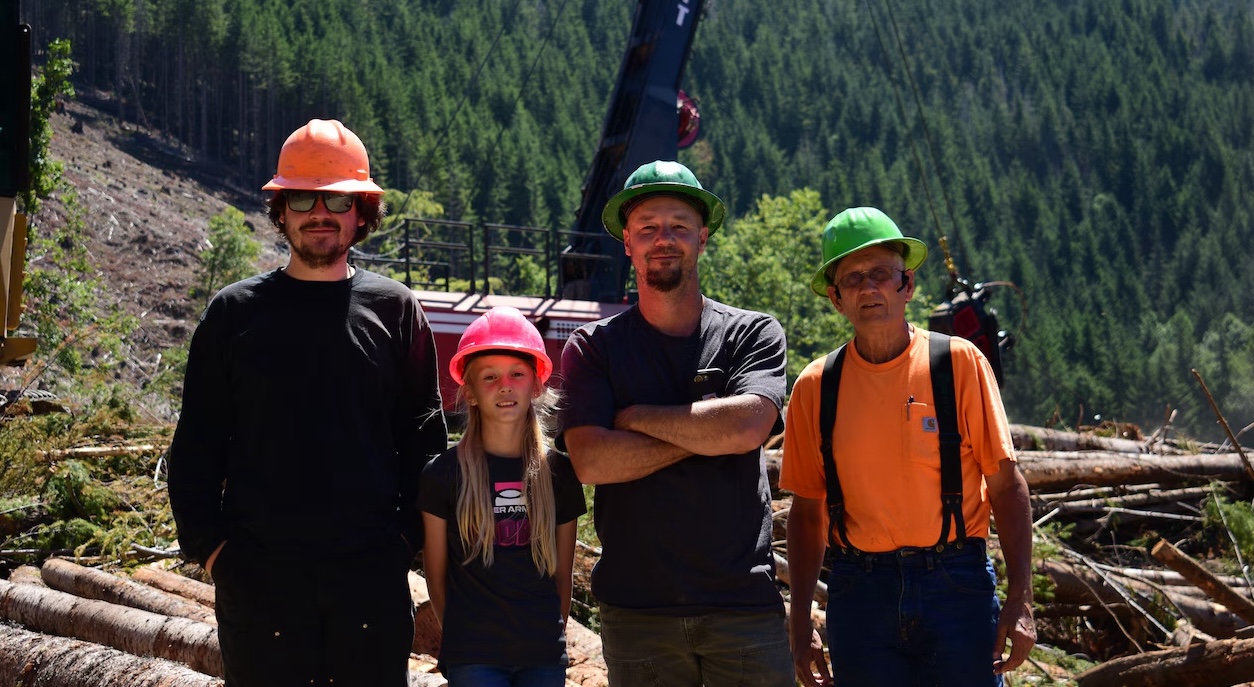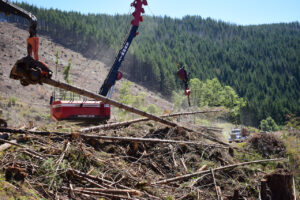
By TRISTIN HOFFMAN/The Oregonian/OregonLive
It’s reaching 90 degrees on the top of a nearly cleared mountain deep in the Willamette National Forest. Dust hangs, never settling, in the air, which smells like freshly-cut pine.
Jeremy Hart’s father, son and an employee of his company, Jeremy Hart Custom Cutting, are working three large harvesting machines — picking up logs from down in the valley, bringing them to a plateau, cutting the logs and placing them into a truck.
What once used to be a job for 12, Hart says, is now a job for three.
Oregon’s forestry sector, once the state’s driving industry, has scaled back dramatically, the result of modernization and reduced harvests since the 1990s. Yet the industry is still adding workers and looking to replace retirees — now with a growing demand for technical expertise.
The industry’s employers say they’re struggling to fill the jobs they have. Retirements have thinned the ranks, turnover is high and new workers are hard to recruit. Adding to the trouble, a workforce study commissioned by the state and compiled by the firm EcoNorthwest found the sector will add 3,400 jobs annually through 2030.
In particular, the report found Oregon’s colleges and universities aren’t producing enough forestry graduates to meet demand — suggesting Oregon employers might have to recruit from elsewhere to staff some of the highest-paying jobs in a signature sector.
It’s a counterintuitive finding for an industry that’s been cutting further in recent months through the closures of mills and factories. Officials say that’s because there’s more to forestry work than logging.
“It’s the logging portion of that industry that has been dropping off,” said Brian Rooney, an economist for Douglas and Lane counties.
Rooney said that mechanization has largely replaced many traditional logging jobs such as loggers, fallers and buckers.

Associated Oregon Loggers, a trade association for logging and forestry businesses, was one of the groups backing the workforce report. Amanda Sullivan-Astor, a forest policy manager for the group, said the jobs most needed in the future might be different from the ones it’s offered in the past.
“Instead of having to hire additional staff, which they are having a hard time finding a lot of times,” Sullivan-Astor said, “they’re looking towards integrating more technology and equipment to hire a few people versus a lot of people. Those few people are often getting paid more and are gaining more transferable skills as well.”
But that doesn’t eliminate the workforce challenges forecast in the report.
“We need 3,400 people a year coming into this sector,” Sullivan-Astor said. “If we want to grow to meet that landscape need, we need to do more.”
Oregon State University’s College of Forestry is preparing its students to operate and maintain that new machinery. In its mechanized harvesting lab, students use remote controls attached to a computer screen to simulate steering machines similar to the ones Hart’s employees use.
“They’re like giant immersive video games,” said Mindy Crandall, an associate professor at the school. “We have this facility that gives people that hands-on experience so they can practice before they go out into the woods.”
Crandall said it’s essential to recruit new workers for the future of the industry. One way to do that, she said, is to show young people — college students and even high schoolers still mapping out their careers — that there might be more to forestry than they expect.
“We have to show people that forestry is an umbrella that holds so many jobs underneath it,” Crandall said. “High-tech jobs in robotics and remote sensing and drones and GIS (computer mapping) in the woods — jobs that are much more than logging.”
The industry also tries to instill an interest in forestry careers among high school students, and the Oregon’s Department of Education also pitches in funding toward the Future Natural Resource Leaders program, which aims to teach forestry practices to students and has chapters at 32 out of Oregon’s 207 public high schools.
But it’s a tough sell, said Lori Loeffer, Tillamook High School’s Future Natural Resource Leaders chapter adviser and a natural resources teacher.
“For them, it’s really hard,” Loeffer said. “Most of them don’t want to get up at 2 or 3 o’clock in the morning, drive out to the forest, go to work, work hard for eight hours a day and then do it all over again the next day.”
Crandall said the OSU College of Forestry’s increased enrollment in recent years but still doesn’t meet the industry demand. That ultimately leads to some companies hiring out-of-state workers to fill the gaps.
“Are we getting enough people coming in to meet the demand? We’re not,” Crandall said. “That’s because we have this disconnect with how people find out about this as an educational path and as a career path.”
Adam Hopkes, a fourth-generation logger and president of Adam Hopkes Logging Company in Tillamook, said technology hasn’t eliminated the arduous manual work most closely associated with the timber industry.
He said workers start out in their careers with more physical jobs, like yarders or buckers, and slowly work their way up to more technical jobs. Those jobs are currently reserved for his 50- to 55-year-old workers, he said.
“Some of that gives the younger generation the wrong impression or false hopes,” Hopkes said. “Because in our industry, even with all the technology, a big part of it is physical. You’re on the ground.”
- Tristin Hoffman covers business and breaking news for The Oregonian/OregonLive. Reach her at thoffman@oregonian.com




















